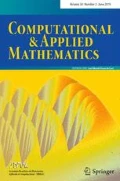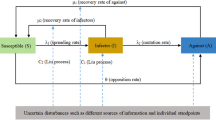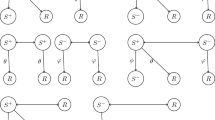Abstract
This paper proposes and investigates a model for rumor spreading and control which accounts for different attitudes and for a distinct type of variable, related to the strength and effectiveness of rumor inhibiting mechanisms. The control mechanisms essentially amount to budgeting and to adjusting the attitude of spreaders. The existence and stability of the trivial (rumor-free) equilibrium and of the semi-trivial equilibrium are characterized in terms of two threshold parameters which quantify the influence of both categories of spreaders. The existence of a positive (rumor-prevailing) equilibrium is also established, its stability being discussed with the help of a bifurcation theorem. A nonstandard finite difference (NSFD) scheme is devised to construct approximate solutions while preserving their positivity, necessary conditions for the existence of the optimal discrete rumor spreading controls being then established.









Similar content being viewed by others
Availability of data and code.
The choices of parameter values have been stated in the body of the paper. The graphs were produced using MATLAB version 2018a, available from https://www.mathworks.com/products/matlab.html.
References
Al-Tuwairqi S, Al-Sheikh S, Al-Amoudi R (2015) Qualitative analysis of a rumor transmission model with incubation mechanism. Open Access Libr. J. 2:1–12
Anguelov R, Lubuma JMS (2001) Contribution to the mathematics of the nonstandard finite difference methods and applications. Numer. Methods Part. Differ. Equ. 17:518–543
Anguelov R, Lubuma JMS (2003) Nonstandard finite difference method by nonlocal approximation. Math. Comput. Simul. 61:465–475
Bodaghi A, Goliaei S (2018) A novel model for rumor spreading on social networks with considering the influence of dissenting opinions. Adv. Complex Syst. 21:1850011
Castillo-Chavez C, Song BJ (2004) Dynamical models of tuberculosis and their applications. Math. Biosci. Eng. 1:361–404
Chen GH (2019) ILSCR rumor spreading model to discuss the control of rumor spreading in emergency. Phys. A 522:88–97
Chen X, Wang N (2020) Rumor spreading model considering rumor credibility, correlation and crowd classification based on personality. Sci. Rep. 10:5887
Daley D, Kendall D (1964) Epidemics and rumours. Nature 204:1118
Daley D, Kendall D (1965) Stochastic rumours. IMA J. Appl. Math. 1:42–55
Dodds PS, Watts DJ (2004) Universal behavior in a generalized model of contagion. Phys. Rev. Lett. 92:218701
Garba SM, Gumel AB, Lubuma JMS (2001) Dynamically-consistent non-standard finite difference method for an epidemic model. Math. Comput. Model. 53:131–150
Goodwin GC, Seron MM, Doná JD (2005) Constrained Control and Estimation: An Optimisation Approach. Springer-Verlag, London Limited
Huo L, Wang L, Zhao X (2019) Stability analysis and optimal control of a rumor spreading model with media report. Phys. A 517:551–562
Jia F, Lv G (2018) Dynamic analysis of a stochastic rumor propagation model. Phys. A 490:613–623
Kawachi K (2008) Deterministic models for rumor transmission. Nonl. Anal. RWA 9:1989–2028
Kumar A, Swarnakar P, Jaiswal K, Kurele R (2020) SMIR model for controlling the spread of information in social networking sites. Phys. A 540:122978
Li M, Zhang H, Georgescu P, Li T (2021) The stochastic evolution of a rumor spreading model with two distinct spread inhibiting and attitude adjusting mechanisms in a homogeneous social network. Phys. A 562:125321
Maki DP, Thompson M (1973) Mathematical Models and Applications. Prentice-Hall, New Jersey, Englewood Cliffs
Mickens RE (1994) Nonstandard Finite Difference Models of Differential Equations. World Scientific, Singapore
Mickens RE (2007) Calculation of denominator functions for nonstandard finite difference schemes for differential equations satisfying a positivity condition. Numer. Methods Part. Differ. Equ. 23:672–691
Moreno Y, Nekovee M, Pacheco A (2004) Dynamics of rumor spreading in complex networks. Phys. Rev. E 64:066130
Musa S, Fori M (2019) Mathematical model of the dynamics of rumor propagation. J. Appl. Math. Phys. 7:1289–1303
Piqueira JR (2020) Rumor propagation model: an equilibrium study. Math. Probl. Eng. 2020:631357
Piqueira J, Zilbovicius M, Batistela C (2020) Daley-Kendal models in fake-news scenario. Phys. A 548:123406
Singh J (2019) A new analysis for fractional rumor spreading dynamical model in a social network with Mittag-Leffler law. Chaos 29:013137
Wang C, Tan ZX, Ye Y, Wang L, Cheong KH, Xie NG (2017) A rumor spreading model based on information entropy. Sci. Rep. 7:9615
Xia LL, Jiang GP, Song B, Song YR (2015) Rumor spreading model considering hesitating mechanism in complex social networks. Phys. A 437:295–303
Xiao Y, Chen D, Wei S, Li Q, Wang H, Xu M (2019) Rumor propagation dynamic model based on evolutionary game and anti-rumor. Nonlinear Dyn. 95:523–539
Zanette D (2001) Critical behavior of propagation on small-world networks. Phys. Rev. E 64:050901
Zanette D (2002) Dynamics of rumor propagation on small-world networks. Phys. Rev. E 65:044908
Zhao L, Qiu X, Wang X, Wang J (2003) Rumor spreading model considering forgetting and remembering mechanisms in inhomogeneous networks. Phys. A 392:987–994
Zhao L, Cui H, Qiu X, Wang X, Wang J (2013) SIR rumor spreading model in the new media age. Phys. A 392:995–1003
Zhu L, Wang B (2020) Stability analysis of a \(SAIR\) rumor spreading model with control strategies in online social networks. Inf. Sci. 526:1–19
Zhu L, Liu M, Li Y (2020) The dynamics analysis of a rumor propagation model in online social networks. Phys. A 520:118–137
Funding
The work of H.Z. was supported by the “Blue Project” of Jiangsu Province and the Humanities and Social Science project of the Chinese Ministry of Education (20YJA630088). The work of T.L. was supported by the social science fund project of Jiangsu Province (No. 17XZB007).
Author information
Authors and Affiliations
Contributions
C.W. and H.Z conceived the study, participated in model formulation and model analysis, and helped drafting the intermediary versions of the manuscript. P.G. participated in model formulation and model analysis, helped drafting the intermediary versions of the manuscript, and drafted the final version of the manuscript. T.L. carried out the stability analysis of the model steady states and helped drafting the intermediary versions of the manuscript. B. Z. helped drafting the intermediary versions of the manuscript. All authors read and approved the final manuscript.
Corresponding author
Ethics declarations
Conflict of interest
The authors declare no competing interests.
Additional information
Communicated by Florence Hubert.
Publisher's Note
Springer Nature remains neutral with regard to jurisdictional claims in published maps and institutional affiliations.
The work of H.Z. was supported by the “Blue Project” of Jiangsu Province and the Humanities and Social Science project of the Chinese Ministry of Education (20YJA630088). The work of T.L. was supported by the social science fund project of Jiangsu Province (No. 17XZB007)
Rights and permissions
About this article
Cite this article
Wenkai, C., Zhang, H., Georgescu, P. et al. Taming obstinate spreaders: the dynamics of a rumor spreading model incorporating inhibiting mechanisms and attitude adjustment. Comp. Appl. Math. 40, 125 (2021). https://doi.org/10.1007/s40314-021-01492-9
Received:
Revised:
Accepted:
Published:
DOI: https://doi.org/10.1007/s40314-021-01492-9
Keywords
- Rumor spreading
- Stability of equilibria
- Conformable spreaders
- Obstinate spreaders
- Influence numbers
- Nonstandard finite difference (NFSD) scheme
- Backward bifurcation
- Fixed horizon optimal control regime




